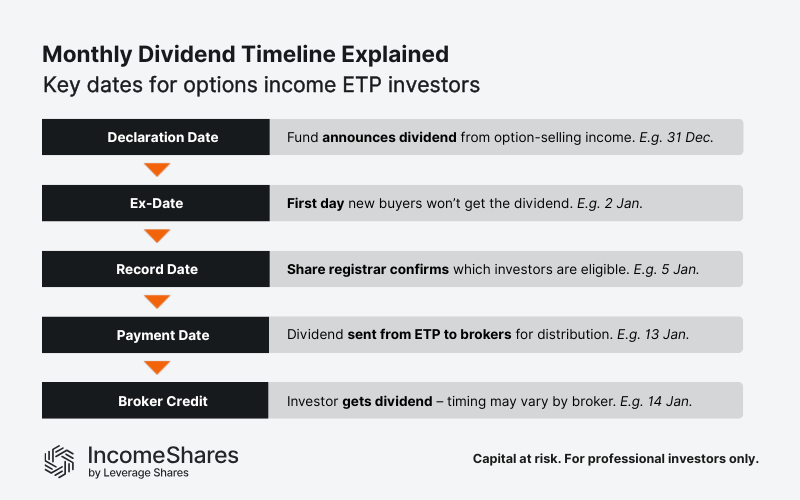.webp)
Auteur
Jonathan Hobbs, CFA
Date
06 Nov 2025
Catégorie
Education
How Dividend Dates Work for Options Income ETPs
Votre capital est exposé à un risque si vous investissez. Vous pouvez perdre la totalité de votre investissement. Veuillez consulter l’avertissement complet sur les risques ici

Options income ETPs aim to earn income by selling options. They then pay out that income to inventors in the form of ETP dividends – aka income distributions. Each dividend follows a clear timeline that shows who qualifies for options income, and when the fund pays it. Here are the key dividend dates that income investors need to understand, and how they affect income payouts.
How do options income ETPs generate income for dividends?
Exchange-traded products (ETPs) trade on the stock market like company shares. When those companies earn a profit, they might pay dividends to investors. Options income ETPs pay dividends, too – except the “profit” comes from selling options for “premiums”.
Most, if not all, of the ETP dividend typically comes from selling options. But if the ETP holds underlying shares or ETFs that pay dividends, it can also add those payments to the income pool. Some options ETPs might hold a bond ETF (like TLT) that pays income from bond coupons. Those coupons could also factor into the ETP dividend equation.
So the total payout could change each month as volatility shifts, option premiums rise or fall, and underlying assets pay different income.
Four key dividend dates explained
Each payment cycle includes four key dividend dates: the declaration date, ex-date, record date, and payment date. Here’s a breakdown of each date, and what they mean for income investors.
Declaration date: The ETP announces the dividend amount and schedule on this date. Investors learn the payment per share and when the fund will distribute it.
Ex-date: The ex-date is the first day the ETP trades without the dividend. In other words, investors must hold the ETP before this date to qualify for the payout. Anyone who buys on or after the ex-date won’t get that month’s dividend.
Record date: The share registrar checks the ETP’s ownership records to confirm who qualifies for the dividend. Investors who held shares before the ex-date get on this list.
Payment date: The ETP sends the dividend to brokers. Most brokers aim to credit investor accounts the same day – but it’s not always a given. Some brokers might process payments one or two business days later, depending on their settlement systems.

Examples: Who qualifies for ETP dividends (and who doesn’t)?
Alice qualifies. She buys an options income ETP on 1 January, one day before the ex-date. Because she holds the ETP before the ex-date, the share registrar lists her on 5 January. She receives the dividend on 13 January or when her broker credits it.
Bob doesn’t. He buys the same ETP on 2 January, the ex-date. His trade settles after the record date, so the share registrar excludes his name. Bob misses the January dividend but will qualify for the next one if he holds before the next ex-date.
This timing difference shows why income investors should track dividend dates carefully. Missing the ex-date by a single day can delay income potential by a full month.
The distribution yield takes the ETP’s dividend payout and divides it by the current net asset value. It then multiples that yield by 12 to get an annualised yield. Read this article to learn more about how distribution yields work.
IncomeShares options ETPs aim to pay monthly income by selling options on a range of underlying assets, including metals, stocks, and bonds. They also hold exposure to the price moves of those underlying assets, which may or may not pay dividends themselves.
Key takeaways
Options income ETPs aim to pay dividends funded by option-selling premiums and (typically to a much lesser extent) dividends from their holdings.
Each monthly payout includes four key dividend dates: declaration, ex-date, record, and payment.
Investors must own the ETP before the ex-date to receive that month’s dividend. Brokers may not always send dividends to investors on the ETP payment date – it depends on the broker’s process.
Votre capital est exposé à un risque si vous investissez. Vous pouvez perdre la totalité de votre investissement. Veuillez consulter l’avertissement complet sur les risques ici
Produits associé:
Stratégie
Option de vente couverte par liquidités + actions
Rendement des
distributions
75.64%
Stratégie
Option de vente couverte par liquidités + actions
Rendement des
distributions
49.39%
Stratégie
Covered call
Rendement des
distributions
12.13%
Stratégie
Basket of Income-generating ETPs
Rendement des
distributions
35.55%
Stratégie
Covered Call
Rendement des
distributions
10.62%
Stratégie
Covered Call
Rendement des
distributions
9.80%
